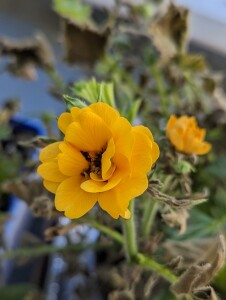 Every year I vow to try new plants in the garden—not necessarily flashy new trademarked hybrids, but species that I haven’t grown before. This year, my first new species comes courtesy of my daughter, who has no garden of her own, but is always on the lookout for plants for me. This year she found an alluring perennial geum variety, ‘Lady Stratheden’.
Every year I vow to try new plants in the garden—not necessarily flashy new trademarked hybrids, but species that I haven’t grown before. This year, my first new species comes courtesy of my daughter, who has no garden of her own, but is always on the lookout for plants for me. This year she found an alluring perennial geum variety, ‘Lady Stratheden’.
The name, with its aristocratic connotation appeals to my inner garden snob. The flowers—rose-like, with fluffy golden-yellow petals, surrounding rings of plentiful yellow stamens and green centers—appeal to my not-so-inner lover of all things rose-like. Some sources identify ‘Lady Stratheden’ as a variety of the species Geum chiloense, but most list it as simply Geum ‘Lady Stratheden’.
‘Lady Stratheden’ is a perfect example of the eighteenth and nineteenth century practice of selecting a choice variety of a newly discovered plant species from another continent and naming it after a member of the British or European gentry. In this case, the real Lady Stratheden was Mary Elizabeth Scarlett, First Baroness Stratheden, a Scottish noblewoman who lived from 1795 to 1860. She was elevated to the British peerage, allegedly, as compensation for the fact that her husband was passed over twice for a lofty judicial job, “Master of the Rolls”. Apparently there is still a Baron Stratheden who is one of Lady Stratheden’s descendants.
And, of course, the Baroness’s namesake flowering plant lives on as well. The chiloense variety came from Chile originally, and was undoubtedly collected in that country by some intrepid plant hunter who brought it back to the British Isles.
Geums are sometimes known as “avens” or even “Grecian rose”, and there is much more to the genus than one yellow-flowered plant. In fact, sources list between 40 and 50 species of geum, native to various temperate parts of the world, including the Americas, as well as areas in Asia, Africa and Europe. A few, like the bright red-orange Geum coccineum, pink-purple Geum rivale, and ‘Lady Stratheden’s progenitor, Geum chiloense, have been widely used for hybridizing. Most of the popular modern varieties are hybrids.
Geums come by their rose-like blossoms honestly, as they are members of the large and far-flung rose or Rosaceae family. The flower structure is similar to that of species roses, with five petals per flower. Double-flowered hybrids abound, and now seem to be more common in commerce than their single-flowered relations. The domestic geums are mid-border plants, sprouting from a basal leaf cluster and rising between nine and 24 inches, depending on species or variety. The foliage is sometimes described as “strawberry-like”, made up of divided, toothed leaves. Species and hybrid flower colors include white, pink, and maroon, as well as brilliant shades of red, orange and yellow. ‘Lady Stratheden’s less aristocratic sibling, ‘Mrs. Bradshaw’ is bright red.
Sunny to lightly shaded spaces are a must for geums. If your soil, like mine, is heavy clay, amend it with organic material when you install the plants. Deadheading will give the plants an incentive to produce new flowers and division each year will increase your supplies. For better or for worse—probably for better—deer will not do the deadheading for you, because they tend to avoid geums.
I suspect that if the deer avoid my new geums, they will spend their time chomping down the burgeoning asters, which is sometimes helpful in preventing the asters from reaching six feet tall by September.
Geum varieties and hybrids are plentiful in the marketplace. As with other popular perennial plants, many are part of named series. For something flamboyant, try ‘Alabama Slammer’, with semi-double orange and gold petals. It is one of the trademarked and undoubtedly intoxicating Cocktails series, which also includes the pinky-apricot ‘Mai Tai’, yellow ‘Banana Daiquiri’, rose and white, ‘Cosmopolitan’, and creamy pink ‘Tequila Sunrise’. You may also see the Tempo series with ruffled flowers in orange, yellow, rose or peach. Equally ruffled, but somewhat more compact—only 10 inches tall–are the plants in the Pretticoats series, including the much publicized Pretticoats ‘Peach’.
Geums generally bloom in mid-spring to early summer, depending on species, variety and climate conditions. They are appearing on nursery pallets now, but are also available from online vendors. Try Plant Detectives, 45 Route 206, Chester, NJ 07930; (908) 879-6577; www.plantdetectives.com.
